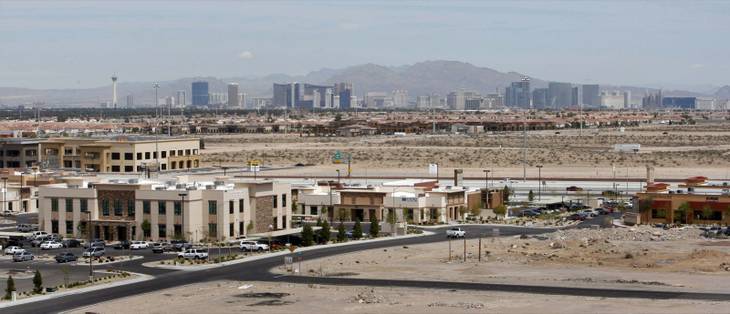VEGAS INC coverage
Retail sales picked up in Las Vegas in 2010, but that isn’t showing up in demand for retail space in 2011, according to research firms tracking the market.
Commercial real estate across the board isn’t faring much better despite improvements in tourism and gaming and a drop in the jobless rate.
The retail vacancy rate stood at 10.4 percent at the end of March, up from 10.2 percent at the end of December but down from 10.7 percent in the first quarter of 2010, according to Applied Analysis. That’s the first quarterly increase after three consecutive quarters of decline, the firm said.
John Restrepo, principal of Restrepo Consulting, pegged the vacancy rate at 12.3 percent, saying more than 5.4 million of 43.9 million square feet of inventory is available.
“Last quarter the anchored retail market hit a floor, but it now appears that there was a trap door,” Restrepo said.
The lack of job creation combined with high consumer debt levels, rising gasoline and food prices and the move to Internet shopping have hurt the retail market, Restrepo said.
Applied Analysis attributed the increased vacancy in part to store closings for Ultimate Electronics, which recently filed for bankruptcy protection.
Applied Analysis Principal Brian Gordon said the retail market will be volatile for the next year and rents are likely to continue to decline.
The average rent requested in the first quarter was $1.53 per square foot per month, down from $1.72 a year ago, Applied Analysis reported. Prices are down 31 percent since early 2008, it said.
North Las Vegas had the highest vacancy rate at 11.8 percent, followed by 11.1 percent in Las Vegas, 10.6 percent in Henderson and 9.3 percent in unincorporated Clark County.
Office market not faring any better
Only Applied Analysis reported an improvement in the vacancy rate in the first quarter, while Grubb & Ellis, CB Richard Ellis, Restrepo Consulting and Colliers reported slight increases.
Applied Analysis said the vacancy rate fell from 24.2 percent at the end of December to 24 percent at the end of March. CB Richard Ellis reported a 24.3 percent vacancy rate, Grubb & Ellis 23.5 percent and Restrepo Consulting 23.3 percent. Earlier this month, Colliers reported a 24.8 percent vacancy rate.
CB Richard Ellis said the office market is improving since it has gone three consecutive quarters where more space has been occupied than vacated.
“We interpret that as a positive indicator that the worst of the down cycle is behind us,” the report released by research director Sara Dinwoodie said.
But Grubb & Ellis said it sees trouble ahead when banks release more of their distressed properties on the market. That should bump up the vacancy rate even more.
“However, it’s likely that this latest increase to vacancy will only be temporary,” said Grubb & Ellis Research Manager Dave Dworkin.
Those newly marketed properties will introduce a lower bottom line for sales prices and lease rates that will become the focus of competition throughout the year, Dworkin said.
Las Vegas isn’t attracting out-of-state companies to fill the office space, Dworkin said. Most of the transactions are locally owned businesses relocating to other parts of town or renewing their leases. Three-year to six-year leases have been common as landlords accept long-term leases with low rates to keep occupancy up, he said.
Restrepo said the office market appears to him as the one sector that should continue to worsen because of an oversupply and lack of job creation.
Applied Analysis said the rents requested declined 5 percent between the first quarter of 2010 and first quarter of 2011.
In that same period, the firm said the vacancy rate rose from 26.5 percent to 27.2 percent in unincorporated Clark County and from 24.5 percent to 24.9 percent in Henderson. In North Las Vegas, the vacancy rate rose from 18.2 percent to 21.2 percent and in Las Vegas it rose from 18.9 percent to 19.8 percent, according to Applied Analysis.
Industrial market
Several firms said the vacancy rate continues to increase, with Applied Analysis reporting it at 17.9 percent, up from 16.9 percent at the end of December.
The industrial market has had increasing vacancy for 18 consecutive quarters, Applied Analysis reported, and lease rates are likely to continue to decline. Rents have fallen more than 8 percent over the past year and are down 33 percent from the peak in mid-2007, the firm said.
The vacancy rate rose from 14.9 percent a year ago in North Las Vegas to 18.5 percent in the first quarter of 2011. Unincorporated Clark County saw its vacancy rate jump from 15.7 percent to 18.3 percent. Henderson’s vacancy rate went from 11.5 percent to 16.4 percent and Las Vegas saw an increase from 14.7 percent to 15.2 percent.
Like the office market, Dworkin said he expects distressed properties to hit the market during the first half of the year, which should temporarily increase the vacancy rate.
Overall, however, he said lease rates and the vacancy rate should remain flat for the year. Renewals are more likely than companies relocating to other space, he said.
